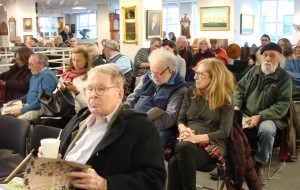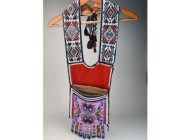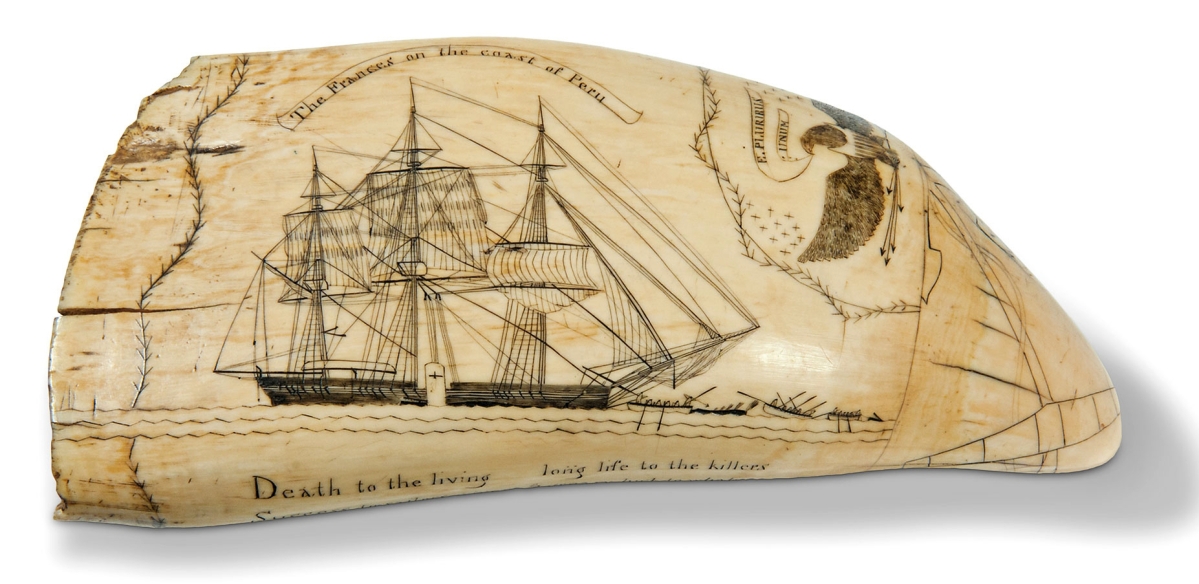
The expected star of the sale was this scrimshaw whale’s tooth by Frederick Myrick, considered by many to be the master of the art. It is believed that he created only about 36 pieces, and this is one of only two depicting the whaleship Frances. They were all done while Myrick was serving aboard the Nantucket whaler Susan on a Pacific voyage from 1826 to 1829. The tooth brought $110,700. Skinner sold the other Frances tooth in 2014 for $123,000.
Review by Rick Russack
BOSTON, MASS. – On March 4, Skinner’s Americana sale included a large selection of scrimshaw. From the collection of the late Ernest Helides and not surprising anyone, the star of the day was a scrimshaw whale’s tooth by Frederick Myrick depicting the whaleship Frances off the coast of Peru, circa 1828-29. The same collection included about 30 whalebone canes, nearly all of which sold over estimates, and there were several scrimshaw teeth from other owners that also did well.
Prices for a collection of New England furniture deaccessioned by Historic Deerfield seemed low, while several pieces of mocha from the collection Jonathan Rickard did well. The sale included folk art portraits by well-known artists, along with other folk paintings, painted furniture, silver, early blown glass, toys and more; it grossed $987,352.
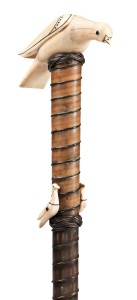
Known as the “Dove Peace” cane, made of baleen and whale ivory, it was topped with a carved dove and included two more doves along the shaft. It brought the highest price of the approximately 30 canes in the sale, $28,290.
Andrew Jacobson, marine arts specialist from Ipswich, Mass., paid $110,700 for the Myrick tooth. On one side, a banner above a whaleship, shown broadside with detailed rigging, read “The Frances on the coast of Peru.” The other side, also showing the ship, included a banner reading “The Frances on her homeward bound passage” and text below identifying her as the “Ship Frances of New Bedford.” The tooth included a spread-winged eagle, a whaling motto and more.
Only two Myrick teeth depicting the Frances are known. They were carved while Myrick was a seaman on a Nantucket whaler, the Susan, during an 1826-29 voyage. On that voyage, Myrick is known to have produced about 36 teeth, all with similar iconography; and, after returning from that voyage, he apparently gave up whaling, settling on a farm in New York State. He did not, so far as is known, produce any additional artwork.
In 2014, Skinner sold the other Frances tooth for $123,000, and Jacobson was also the buyer. That particular tooth had first surfaced when brought in to an Antiques Roadshow event in 2015, where it had been appraised by Allan Katz. Of the 36 teeth believed to have been carved by Myrick, 30 depict the Susan, the ship he sailed on, two depict the Frances and four depict another Nantucket whaler, the Barclay.
The Frances tooth from the Helides collection was well-known to collectors, some of whom considered it one of the better examples of Myrick’s work, with very clear and distinct engraving, in good condition, and it was slightly larger than the one Skinner sold in 2014. The tooth had previously sold in 1979 for $29,000 at a Richard Bourne auction and again at a Bourne auction in 1989, when it brought $26,400. Jacobson said he believes there was a private sale between the two auction sales.
Ernest Helides, who died in 2016, had been collecting scrimshaw for about 30 years and amassed a large collection. He particularly liked whalebone walking sticks, or canes, and this Skinner sale included about 30 of them. Jacobson said Helides had about 500 walking sticks, so we can probably expect that more will follow. Nearly all sold well over Skinner’s conservative estimates, with a baleen and whale ivory one bringing $28,290 against an estimate of $3,000. That particular stick is known as the “Dove Peace” stick because it has a carved whalebone winged dove at the top of the shaft and two other doves lower down on the shaft. It has an interesting provenance, having once been owned by Barbara Johnson, and, as the story goes, it had been owned originally by the captain of a whaler that was part of the 13 ships of the “Great Stone Fleet,” which was to be sunk in Charleston Harbor during the Civil War to deny the harbor to ships supplying the Confederate states.
Proceeds from the sale of the Helides collection, which totaled $215,589, are earmarked for charity. When Stephen Fletcher, Skinner’s executive vice president, was asked about other material in the Helides collection, he said, “We’ll be selling more of it. Unfortunately, the collection includes some ivory items, that could legitimately be sold if they had proper documentation, but many pieces don’t and they’ll be donated somewhere.”
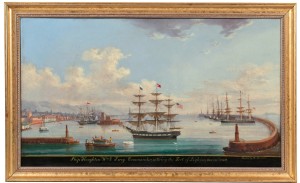
The legend underneath this painting by M. Renault (French, Nineteenth Century) identified the scene as the “Ship Houghton, Wm. G. Percy Commander, entering the Port of Leghorn, November 24th, 1862.” It was the top selling marine painting of the day, finishing at $22,140.
According to Jacobson, the scrimshaw market is strong and vibrant, while like other facets of the antiques market, it has not yet, in general, returned to prerecession prices. As with other specialties, the finest pieces find a ready market while lesser pieces may struggle. Also affecting the current market is the fact that several “old-time” collections are coming to market over the coming months, so collectors will have plenty to choose from. It is likely that at least two more Susan’s teeth will be offered later this year, along with works by other major scrimshanders, perhaps making this an advantageous time to buy. Jacobson pointed out that since most collectors do not seek more than one of the Susan teeth, it will be interesting to see what the next two will sell for. Jacobson has an interest in following the market trends as he presents a talk, “Scrimshaw Market Update,” annually at the New Bedford Whaling Museum’s Scrimshaw Weekend, which this year will be conducted in mid-May.
The sale started off with 27 pieces of mocha from the well-known Jonathan Rickard collection. Rickard is the author of the essential reference on mocha, has written several articles and acted as curator for major exhibits at Colonial Williamsburg and other museums. His collection will also be featured in Skinner’s August Americana sale and will include perhaps as many as another 100 lots. The first Rickard lot to be offered in this sale, a pearlware coffee pot with multiple decorative techniques, including engine turning, brought the highest price of collection, finishing at $2,583.
The day after the sale, Rickard said that he had thought that coffee pot would do a little better, and that there seemed to be quirks with some of the results. “One quirk came when the marbled and combed quart frog mug went low at $1,400 and the next lot, a marbled and combed pint mug sans froggy brought $1,600. I thought the coffee pot would have gone higher, but I recognize that engine-turned designs aren’t generally appreciated as much as I think they should be.” Again, most prices have not yet gotten back to prerecession prices, with some selling for less than he paid for them. Rickard said that he will be using the proceeds from the these sales to make some improvements to his home.
Historic Deerfield deaccessioned more than 60 items that were either duplicates of other items the institution owned or were outside its collecting interests. The items, from the Lucius D. Potter Memorial Collection, had been given to the museum in 1960 by his widow, Rowena Russell Potter. Included were three pieces of blockfront furniture, early brass candlesticks and other furniture. Dealers Richard and Dianne Angelo, Keystone Crossing Antiques, Milford, N.H., bought some of the blockfront pieces, including a Massachusetts four-drawer chest, for which they paid $6,675, along with other furniture.
A Boston blockfront slant lid desk, estimated at $6/8,000, did not get any bids, and a Massachusetts blockfront bureau table sold for $3,998. Both the Angelos and another dealer in the room agreed that the passed desk was a form that does not interest today’s buyers. Most of these pieces had been refinished and most had other imperfections.
This consignment included a small, unusually made ball foot, five-drawer chest consisting of a variety of woods. It was cataloged as being constructed of sapele (a type of mahogany), rosewood and pine and as possibly being from Nantucket, dating to the early Eighteenth Century. It had an old label that indicated “it had been in the possession of Micajah Coffin in 1740 and shown in a loan exhibition of Nantucket heirlooms at Charles G. Coffin mansion in 1935.” The fronts of some of the drawers comprised two thick pieces of wood, were not matching, and details such as dovetailing varied from drawer to drawer. Although it may have looked like one of the drawers was a replacement, it was not. Fletcher and others who looked at it, said, “It looks like whoever made it used whatever wood was laying around. You have to wonder where the guy got the wood. Rosewood certainly isn’t native to Nantucket. But people liked the provenance that went with it.” The chest was estimated at $1,500 and finished at $5,228.
Not all the furniture came from the Deerfield consignment. An Eighteenth Century walnut veneer inlaid maple high chest, probably made in Massachusetts, with string inlay, veneer borders and an old surface, finished at $12,300. A Salem carved mahogany sofa with bird’s-eye maple inlays, circa 1810, realized $5,535.
Skinner provides two days for interested bidders to preview the material being offered. Furniture is displayed in such a way that it can easily be examined: drawers can be removed, pieces can be turned over so that construction details can be observed, and silver, ceramics and other smalls can easily be handled with the assistance of Skinner’s staff. The area is well lighted, and Skinner’s experts – Fletcher, Chris Barber and Chris Fox – are on hand to assist with examinations and add whatever other information they can provide. These previews truly offer a useful learning experience and in some cases, Skinner’s staff, dealers and collectors collectively discuss an object.
Often, there will be a presentation the evening before an auction by an authority on some of the items in the auction. The evening before this sale, Stuart Frank, PhD, author of numerous books and articles on whaling and scrimshaw, presented “The Hallowed Halls of Scrimshaw.”
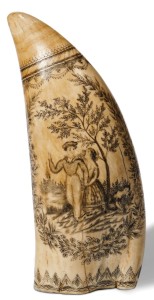
Attributed to the “Banknote Engraver,” this well-done tooth had a “Sailor’s Farewell” scene on one side with the lovers and a sailing ship on the reverse. It realized $20,910.
The Americana sales included a wide selection of folk art and paintings. A pair of portraits attributed to William Matthew Prior (American, 1806-1873) finished at $9,225, and a pair of signed and dated portraits of children by Susan Waters (American, 1823-1900), achieved $14,760. The sale included four paintings by Thomas Chambers (American English, 1808-1869). A river valley scene, with rugged cliffs, a house and people realized $20,910.
The selection of marine paintings was topped by an oil on canvas by M. Renault (French, Nineteenth Century), which was titled below the scene, “Ship Houghton, Wm. G. Percy Commander, entering the Port of Leghorn, November 24th, 1862.” The Houghton, built by Levi Houghton & Sons, Bath, Maine, in 1849, is depicted under a blue sky with several other ships and port buildings visible. It attained $22,140. Another marine painting, cataloged as American School, circa 1856-60, an unsigned oil on canvas showing the yacht Julia in the New York Yacht Club Race off Sandy Hook, N.J., finished at $6,675. Five lots offered whale and dolphin carvings by Carl Voorhees Jr (1911-1980). The most sought after was a carved and painted full-body sperm whale, with open mouth and teeth showing, which reached $4,305.
After the sale, Steve Fletcher said, “We’re pleased with the results. The canes did well and went to a variety of buyers from all over the country, so we know the word was out. I thought the Myrick tooth might have brought a little more, but it was still a good number. Several things are going into public collections so that they’ll be available for people to see. We’ll have more mocha and more scrimshaw in upcoming sales and Jonathan Rickard will give a talk on his collection, probably the day before the August sale.”
All prices reported include the buyer’s premium.
For additional information, www.skinnerinc.com or 617-350-5400.

